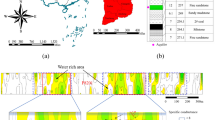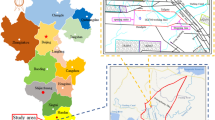Abstract
This paper presents a case study of water inrush on a mine working face from roof strata. The flow-rock failure process analysis (F-RFPA2D) code with an improved flow-stress-damage (FSD) model was adopted to perform the failure and coupling analysis. The improved FSD model was used to represent the permeability variation at the four stages (elastic, damaged, cracked, and crack closure) of the rock failure process. The fracture initiation, propagation, and coalescence in the stressed strata and the seepage field evolution in the stress field are represented visually during the whole process of water inrush. The failure zone with high permeability induced by mining disturbance becomes the water-conducting zone after full excavation of the coal seam. The height of the water-conducting zone obtained in this study is in reasonable accordance with that predicted by an empirical formula. It is definitely clarified that the water inrush from the roof strata is induced by the failure zone full of vertical coalesced mine fractures. It is unlikely that roof accidents resulting in water inrush would occur if the water-conducting zone does not grow upwards into the aquifer. The main task for mine extraction under a confined aquifer is to locate the aquifer and find the maximum height of the water-conducting zone, which is very important for mine construction and support design.








Similar content being viewed by others
Abbreviations
- H :
-
maximum height of failure zone
- M :
-
excavated seam thickness
- a, b :
-
coefficients depending upon the stratum lithology
- c :
-
mean square deviation
- \( \phi \) :
-
Weibull’s distribution function
- s :
-
strength or elastic modulus of a certain single element
- s 0 :
-
mean value of the element parameters for the whole specimen
- m :
-
homogeneity index
- \( \sigma _{ij} \) :
-
total stress in the ij-plane
- \( X_j \) :
-
body force in the jth direction
- \( \varepsilon _{ij} \) :
-
strain in the ij-plane
- \( u_i \) :
-
displacement in the ith direction
- \( \sigma ^{\prime}_{ij} \) :
-
effective stress in the ij-plane
- p :
-
pore pressure
- α :
-
coefficient of pore-fluid pressure
- λ :
-
Lamé coefficient
- G :
-
shear modulus
- δ ij :
-
Kronecker constant
- k :
-
coefficient of permeability
- Q :
-
Biot constant
- k i :
-
initial coefficient of permeability
- ξ, β :
-
material constants
References
Bai M, Elsworth D (1993) Dual-porosity poroelastic approach to behavior of porous media over a mining panel. Trans Inst Min Min 102:A114–A124
Bai M, Elsworth D (1994) Modeling of subsidence and stress-dependent hydraulic conductivity for intact rock and fractured porous media. Rock Mech Rock Eng 27(4):209–234
Biot MA (1941) General theory of three-dimensional consolidation. J Appl Phys 12:155–164
Brady BHG, Brown ET (1992) Rock mechanics for underground mining, 2nd edn. Chapman & Hall Press, London, pp 571–580
Cheng QM, Zhang G, Lu C, Ko C (2004) GIS spatial-temporal modeling of water systems in greater Toronto area, Canada. J China Univ Geosci 15(3):275–282
Hodlur G, Prakash RM, Deshmukh S, Singh V (2002) Role of some salient geophysical, geochemical, and hydrogeological parameters in the exploration of fresh groundwater in a brackish terrain. Environ Geol 41(7):861–866
Dumpleton S, Robins NS, Walker JA, Merrin PD (2001) Mine water rebound in south Nottinghamshire: risk evaluation using 3-D visualization and predictive modeling. Q J Eng Geol Hydrogeol 34(3):307–319
Gehle C, Kutter HK (2003) Breakage and shear behavior of intermittent rock joints. Int J Rock Mech Min Sci 40:687–700
Hudson JA, Fairhurst C (1969) Tensile strength, Weibull’s theory and a general statistical approach to rock failure. In: The proceedings of the civil engineering materials conference, Southampton, pp 901–904
Liu T (1981) Coal mine ground movement and strata failure. Coal Industry Publication House, Beijing, pp 50–70
Liu J, Elsworth D, Brady BH (1999) Linking stress-dependent effective porosity and hydraulic conductivity fields to RMR. Int J Rock Mech Min Sci 36:581–596
Mahnken R, Kohlmeier M (2001) Finite element simulation for rock salt with dilatancy boundary coupled to fluid permeation. Comput Methods Appl Mech Eng 190:4259–4278
Miao X, Qian M (2003) Broken feature of key strata and its influence on rock pressure in super-length fully-mechanized coal face. Chinese J Rock Mech Eng 22(1):45–47
Miao X, Chen R, Pu H, Qian MG (2005) Analysis of breakage and collapse of thick key strata around coal face. Chinese J Rock Mech Eng 24(8):1289–1295
Mohamed AR, Hansen W (1999) Micromechanical modeling of concrete response under static loading—Part I: Model development and validation. ACI Mater J 96(2):196–203
Paterson S (1978) Experimental deformation of rocks: the brittle field. Springer, Berlin, pp 123–158
Peng SS, Chiang HS (1984) Longwall mining. Wiley, New York, pp 708–712
Qian MG (1983) Control technique of mining pressure. Coal Industry, Beijing, pp 79–80
Schangen E, Van Mier JGM (1992) Experimental and numerical analysis of micromechanisms of fracture of cement-based composites. Cement Concr Compos 14:105–118
Schulze O, Popp T, Kern H (2001) Development of damage and permeability in deforming rock salt. Eng Geol 61:163–180
Sergion B, Djebbar T (1997) Interpretation of stress damage on fracture conductivity. Int Pet Sci Eng 17:71–85
Shen B (2001) FRACOD2D. Two dimensional fracture propagation code. User’s manual, Fracom Ltd, pp 82–95
Shen B, Stephansson O (1994) Modification of the G-criterion for fracture propagation subjected to compression. Eng Fract Mech 47(2):177–189
Simpson G, Gueguen Y, Schneider F (2001) Permeability enhancement due to microcrack dilantancy in the damage regime. J Geophys Res 106:3999–4016
Song ZQ (1988) Applied control technique for mining pressure. Press of Chinese University of Mining Technology, Xuzhou, pp 40–58
Song L, Zhang HQ, Liang ZZ, Jiao MR (2005) Effect of element size on rock shear strength and failure pattern by rock failure progress analysis (RFPA2D). Key Eng Mater 297–300:2573–2578
Tang CA (1997) Numerical simulation on progressive failure leading to collapse and associated seismicity. Int J Rock Mech Min Sci 34(2):249–261
Tang CA, Yang WT, Fu YF, Xu XH (1998) A new approach to numerical method of modeling geological processes and rock engineering problems-continuum to discontinuum and linearity to nolinearity. Eng Geol 49:207–214
Tang CA, Liu H et al (2000) Numerical studies of the influence of microstructure on rock failure in uniaxial compression—Part I: Effect of heterogeneity. Int J Rock Mech Min Sci 37:555–569
Tang CA, Tham LG, Lee PKK, Yang TH, Li LC (2002) Coupled analysis of flow, stress and damage (FSD) in rock failure. Int J Rock Mech Min Sci 39:477–489
Thomas JB, Tamim Y, Eric TA (2000) Hydrologic analysis of discharge sustainability from an abandoned underground coal mine. J AmWater Resour Assoc 36(5):1161–1172
Van Mier JGM, Van Vliet MRA (1999) Experimentation, numerical simulation and the role of engineering judgement in the fracture mechanics of concrete and concrete structures. Constr Build Mater 13:3–14
Yang TH, Tang CA, Zhu WC, Feng QY (2001) Coupling analysis of seepage and stress in rock failure process. Chin J Geotech Eng 23(4):489–493
Yang TH, Tham LG, Tang CA, Liang ZZ, Tsui Y (2004) Influence of heterogeneity of mechanical properties on hydraulic fracturing in permeable rocks. Rock Mech Rock Eng 37(4):251–275
Yavuz H (2004) An estimation method for cover pressure re-establishment distance and pressure distribution in the goaf of longwall coal mines. Int J Rock Mech Min Sci 41(2):193–205
Zhang S (1986) FEM analysis on mixed-mode fracture of CSM-GRP. Eng Fract Mech 23(3):523–535
Zhang JC (2005) Investigations of water inrushes from aquifers under coal seams. Int J Rock Mech Min Sci 42:350–360
Zhang L, Franklin JA (1993) Prediction of water flow into rock tunnels. An analytical solution assuming an hydraulic conductivity gradient. Int J Rock Mech Min Sci Geomech Abstr 30(1):37–46
Zhang JC, Shen B (2004) Coal mining under aquifers in China: a case study. Int J Rock Mech Min Sci 41:629–639
Zhang JC, Zhang YZ, Liu TQ (1997) Rock mass permeability and coal mine water inrush. Geological Publication House, Beijing, pp 85–98
Zhang HQ, Zhao ZY, Tang CA, Song L (2006) Numerical study of shear behavior of intermittent rock joints with different geometrical parameters. Int J Rock Mech Min Sci 43:802–816
Zhao DS, Su ZJ, Sui HQ, Liu WS, Fan XL (1997) Laboratory simulation research of slowing down the surface subsidence by separated strata grout. J China Coal Soc 22(6):571–575
Zhou XP (2004) Analysis of the localization of deformation and the complete stress-strain relation for mesoscopic heterogeneous brittle rock under dynamic uniaxial tensile loading. Int J Solids Struct 41:1725–1738
Zhu WL, Wong TF (1999) Network modeling of the evolution of permeability and dilatancy in compact rock. J Geophys Res 104(B2):2963–2971
Zoback MD, Rummel F, Jung R, Raleigh CB (1977) Laboratory hydraulic fracturing experiments in intact and pre-fractured rock. Int J Rock Mech Min Sci 14:49–58
Acknowledgments
This study was supported by NSFC (Nos. 50490273, 50774082, 50674083 and 40638040).
Author information
Authors and Affiliations
Corresponding author
Rights and permissions
About this article
Cite this article
Zhang, H.Q., He, Y.N., Tang, C.A. et al. Application of an Improved Flow-Stress-Damage Model to the Criticality Assessment of Water Inrush in a Mine: a Case Study. Rock Mech Rock Eng 42, 911–930 (2009). https://doi.org/10.1007/s00603-008-0004-2
Received:
Accepted:
Published:
Issue Date:
DOI: https://doi.org/10.1007/s00603-008-0004-2




